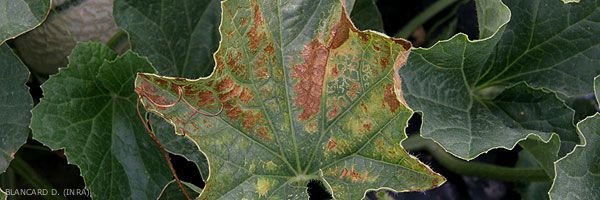
Physiological grill
This non-parasitic disease is frequently observed in melon plots, in the open field as well as under cover, causing very characteristic leaf necrosis and drying out which sometimes leads to the death of plants.
Several leaf symptoms can be observed :
Several leaf symptoms can be observed :
- rapidly necrotizing inter-nervous chlorotic areas (Figures 1, 3 and 5);
- inter-vein browning rapidly becoming necrotic (Figures 2 and 4);
- generalized drying out of leaves remaining attached to the twigs.
It should be noted that the destruction of the leaves exposes the melons to sunburn, making them subsequently unmarketable. In addition, root degradation has been observed on plants showing crown blight.
Although the exact cause of scorching is not known precisely, it seems that its symptoms at some point reflect an imbalance between the water demand of the above-ground vegetation, linked in part to the fruit load, and what may provide the root system with sometimes somewhat reduced volume. Among the factors favoring it, we can mention:
- inter-vein browning rapidly becoming necrotic (Figures 2 and 4);
- generalized drying out of leaves remaining attached to the twigs.
It should be noted that the destruction of the leaves exposes the melons to sunburn, making them subsequently unmarketable. In addition, root degradation has been observed on plants showing crown blight.
Although the exact cause of scorching is not known precisely, it seems that its symptoms at some point reflect an imbalance between the water demand of the above-ground vegetation, linked in part to the fruit load, and what may provide the root system with sometimes somewhat reduced volume. Among the factors favoring it, we can mention:
- those having a direct impact on the development of the melon root system at the start of cultivation, such as the nature of the soil, for example; the climate with cold weather and / or cold, wet soil at planting and in the weeks that follow; limited attacks from certain root pests ...
- those linked to cultivation techniques and varietal choices, such as poor soil preparation, too severe pruning of plants; the use of not very vigorous varieties always more sensitive to this physiological disease.
In order to avoid the manifestation of scorching in melon crops, it is advisable to:
- choose vigorous melon varieties with a powerful root system;
- avoid plots where soil pests are already rife;
- ensure the plants maximum comfort;
- do not plant too early, in cold and poorly draining soils;
- preventively carry out treatments based on lime nitrate and magnesia from the start of fruit growth and several times thereafter.
- choose vigorous melon varieties with a powerful root system;
- avoid plots where soil pests are already rife;
- ensure the plants maximum comfort;
- do not plant too early, in cold and poorly draining soils;
- preventively carry out treatments based on lime nitrate and magnesia from the start of fruit growth and several times thereafter.





